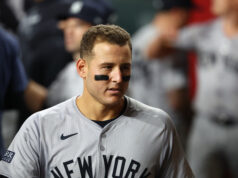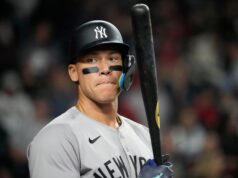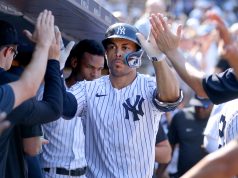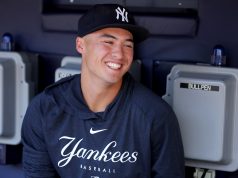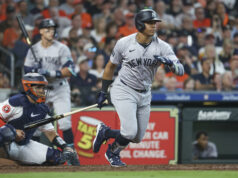Although Brett Gardner has been inconsistent since his last All-Star appearance, he is now showing the New York Yankees that he still has it.
Ever since New York Yankees left fielder Brett Gardner slumped after his 2015 All-Star appearance, the speedster has probably heard it all from the fan base.
Whether it was the masses calling for the organization to trade, bench or release him over the last two years, one of the most underrated players in Yankees’ history has finally started to stand up for himself — with the bat.
The Yankees’ leadoff hitter opens the month of June fresh of the greatest offensive month of his career. Gardner finished May with the fifth-highest wRC+ (185), fourth-highest slugging percentage (.673), the third-most home runs (9) and the eighth-most runs scored (23) among Major League hitters. This astronomical month has helped spike his slash line — which stood at .188/.316/.234 entering play on April 29 — to .276/.365/.529 on the season.
He’s found his power stroke and is tied with battering partner Matt Holliday for the second-most home runs (11) on the Yankees this season behind Aaron Judge (17) while also trumping his total from 2016 (7).
“I’ve just been consistent in my work,” Gardner said following the Yankees win in Game 2 of their three-game set with Baltimore. “Good balance, good timing, good rhythm and things are working out.”
Brett Gardner gets the Yankees on the board early with a leadoff home run to right field off Chris Tillman, his 10th of the year!!! pic.twitter.com/BFn0a3z0QR
— TheRenderMLB (@TheRenderMLB) May 30, 2017
This performance shouldn’t make one misremember a couple of aspects, though. Firstly, 2016 was certainly a mediocre one for the longest-tenured Yankee. His OPS of .713 was the second-worst of his career and while he took home his first career Gold Glove, he only stole 16 bases — the lowest of his seven full seasons.
Plus, this isn’t the first time he’s surged out of the gate. Back in 2015, Gardner slashed .302/.377/.484 en route to his first Midsummer Classic appearance of his career but would fall down to Earth in the second half. Among the 123 batters with 250 plate appearances or more in the second half, Gardner’s on-base percentage of .300 ranked 102nd.
Knowing the streaky tendencies, the latest cool-off (which was one of the many reasons why New York blew their American League East lead to the Toronto Blue Jays) and the current state of the organization, should the front office consider selling high?
It seems as though the time to do so was this past offseason, but we may never see the 33-year-old’s stock be this high again. In a youth movement, it shouldn’t be frowned upon to move past a mid-30’s outfielder who is owed $24 million from now until 2019 — when his four-year, $52 million contract expires.
While Gardner currently holds the status as an asset for contending clubs that are in desperate need of a championship now, the Yankees really shouldn’t wait to jump on an attractive offer. Especially if top outfield prospect Clint Frazier (nine home runs in 47 games for Triple-A Scranton/Wilkes-Barre) is deemed ready and Gardner’s return features a starter or reliever that can help the Yankees win now, as they nonetheless own sole possession of first place in the AL East.
Even if Frazier isn’t ready by July, Aaron Hicks and his Major League’s eight-best wRC+ of 162 among outfielders (min. 150 PA) would easily slide in and make an impact similar to Gardner’s. Don’t forget about the low-key prospects like Dustin Fowler, who’s tied with super prospect Yoan Moncada for the sixth-best batting average (.312) in the International League.
Yet, you can’t ignore 2017. Gardner is one of the greatest leaders in the clubhouse, has been in the game for almost a decade, has won a World Series and does nothing but grind for his team. You’re talking about losing a valuable asset not only to your contending squad but the Baby Bombers as well.
But the bigger picture doesn’t lie and Gardner’s trade value, especially considering he’s about to enter his mid-30s, may never reach this level again. This conversation will be picked up again come July and while it seems counterproductive to do sell a valuable piece of a winning team, this is still a youth movement.




